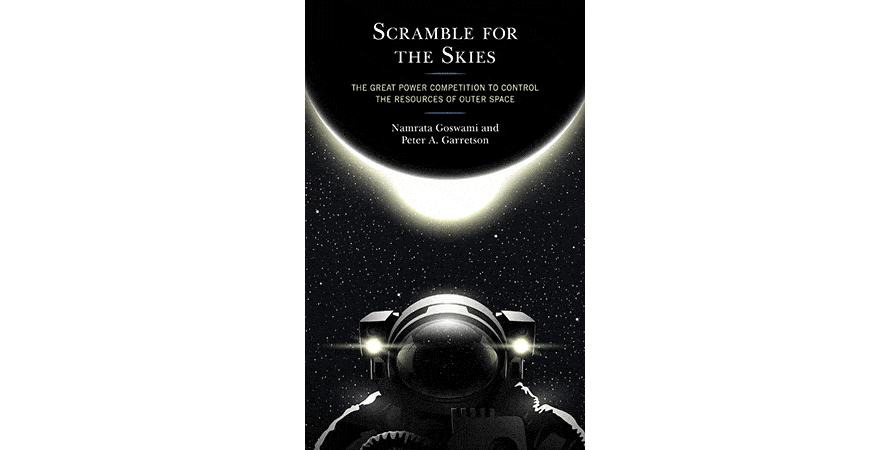Category: Non-Fiction
Reviewed by Clifford R. McMurray
Title: Scramble for the Skies: The Great Power Competition to Control the Resources of Outer Space
Author: Namrata Goswami and Peter A. Garretson
NSS Amazon link for this book
Format: Hardcover, Kindle
Pages: 464
Publisher: Lexington Books
Date: October 2020
Retail Price: $135.00/$128.00
ISBN: 978-1498583114
“Maybe in the next 20 years we are also looking at some kind of colonization of space. And the dawn of a new space race. A race that will advocate the most basic of human concepts, nationalism. It will be like the race for colonies. In the 17th/18th century, one that conquered the sea, conquered the world. In the next 50 years, the battle ground will be space and countries will compete.”
That statement didn’t come from a policymaker in America or China or Russia; it came from a space entrepreneur in India. It’s a good summary of the thesis of this book. Authors Garretson and Goswami argue that the fundamental basis for international competition in space is shifting from a race for prestige to a race for the practically limitless natural resources of the solar system. Those resources – both material and energy – will enrich and transform the global economy, and whoever controls the largest share of those resources will increase in national power relative to the nations that control less, or none.
Up to now, commercial space has been dominated by communications and information applications, but very soon entrepreneurs and state-run companies will be able to start tapping the mineral wealth of the Moon and asteroids. The first competition will be for the most basic resource of all: water. Water will be the oil of space, providing drinking water and oxygen for life support of humans and food crops, and oxygen and hydrogen for rocket fuel. Ice is available in permanently shadowed craters on the Moon, mainly located at the lunar poles, and in many near Earth asteroids. It’s much cheaper to process and transport those materials in the low gravity of the Moon and microgravity of the asteroids than to haul them up from Earth’s deep gravity well. Using lunar and asteroid ice drastically lowers the cost of space transportation, and opens up the inner solar system to mining of minerals for use in space construction and on Earth itself.
How much wealth would that create? A frequently cited example is the near Earth asteroid Amun 3554, whose iron, nickel and platinum are valued at $20 trillion (more than the GDP of Japan, Germany, the United Kingdom, France and India combined). And that’s just one relatively small asteroid, among tens of thousands. Mining more humble minerals like silicon and aluminum will make possible the construction of solar power satellites, giving Earth a cheap, nonpolluting source of electricity to power its earthside industries.
With those kind of stakes, human history leaves little doubt that there will be competition for them. The only question is what form that competition will take. Will it be peaceful and conducted within the bounds of international consensus and law, or will it take more, ahem, “muscular” form? Goswami and Garretson don’t set out to answer that question directly. Instead, their purpose is to analyze the developing strategic thought about space resources in the countries that they see as being the primary competitors: the three “great powers” of America, China and India, and two of the most active “middle powers” (defined as “those states in the international system whose position is below the great powers, but with enough power, capacity and influence at their disposal to shape international regimes and events”), Luxembourg and the United Arab Emirates. It’s a little surprising that they have almost nothing to say about Russia or Japan, except that they are “outside the scope” of their study. However, each of the nations they treat is subjected to a thorough analysis. From an understanding of how they’ve reacted in the past, and what their policy elites are saying today, the authors seek some insight as to how these nations are likely to behave in the scramble for space riches.
Be warned: this book is not a light afternoon read. It’s written in a dense scholarly style, and Goswami and Garretson are forthright in stating that their primary target audience is the academic and policymaking communities. To give you an example of the flavor, one chapter is titled “The Epistemic Community and the Foundations of Discourse in the United States.” That said, the text is massively footnoted and there’s a huge bibliography that more casual readers will find a gold mine for further reading. And all but the most knowledgeable readers will find their own command of the subject matter increased, if they’re willing to put in the time this book requires.
National Space Society members will be pleased to find that NSS is treated as a thought leader in the text, and NSS position papers the NSS Roadmap to Space Settlement are cited several times.
© 2020 Clifford R. McMurray
Please use the NSS Amazon Link for all your book and other purchases. It helps NSS and does not cost you a cent! Bookmark this link for ALL your Amazon shopping!



















